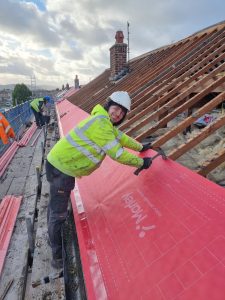Case Study Information
- Welsh programme: ORP
- Type: Retrofit
- Stage: Operational
- Design standard: PAS 2030/35
- Other measure: Battery storage (BESS)
- Other measure: In use monitoring
- Other measure: Solar PV
Background
Denbighshire County Council, through ORP 1 funding, have carried out a test and learn programme detailing how to optimise the roll out of retrofit measures to reduce CO2 emissions and support tenants in Denbighshire. For ORP 1.0, 54 properties in Meliden, Prestatyn were chosen to have rockwool EWI, new Roofs, Roof insulation, PV systems and Batteries with the aim of reducing CO2e making homes warmer, providing lower electricity bills and improve lives. Properties also had wired in gateways and sensors to monitor energy use and the environment. The findings from data collected from the solar PV and environmental sensors, as well as tenant feedback, and updated EPC certificates, show that decarbonisation can be beneficial to tenants and the environment. The project started in January 2020 and was completed by May 2022.
Project learning
- After retrofit works, all properties were raised to an EPC A, B, or C
- The PV was analysed to identify the best performance. This was found to be unsurprisingly on South facing orientations, however the shadows on roofs also affect how well a PV system operates. Batteries were in storage longer than desired time scales due to Covid 19 lockdowns and such have required additional maintenance, it has been decided not to replace these systems until the maintenance and health and safety requirements for batteries is better understood.
- Analysis of savings shows a wide variation of benefits depending on external factors; however all properties have seen savings from the insulation and PV.
- Chimneys, and trees, can greatly reduce the energy generated as inverters are not designed for panels all producing different amounts of electricity. For later (post ORP 2.2) we used Power Optimisers which help to reduce the loss due to shadows. We also will consider Micro Inverters. The final option to optimise PV is to only place panels on the South facing orientation (See Case Study for ORP 3.2 Denbighshire) This is easier where all properties on a street are south facing.
- Jobs fair supported by Sustainable Building Services (UK) Ltd at Rhyl town hall, where 10 people showed an interest in a career in retrofit.
- Technology is always evolving, future proofing properties can be complicated, and it is better to do smaller projects and always looking to find cheaper (technology and data), more efficient, and more tenant and maintenance friendly devices.
- PV, inverters, and batteries were installed alongside training for the installation of these technologies in social housing. Learning from orientation of PV panels, the maintenance requirements of batteries and the impact of shadows form chimneys, neighbouring buildings, and trees are now better understood.
Project innovation
This project saw the first use of PV in social housing for Denbighshire County Council; the first use of IES and Environmental sensors in DCC houses, and the first use of Rockwall EWI at DCC.
Challenges
- Three properties did not have PV due to party wall issues
- Seven properties unfortunately did not have EWI due to access issues
- Installing and getting the benefits of IES and Environmental sensors relies on several limiting factors: access to the property, correct installation, correct reading of QR codes and serial numbers, a good internet connection, the cost of telecom data, a good dashboard which correctly display data, as well as correct analysis of data. Barriers in any part of this chain results in expensive data gaps
- Batteries went in late due to Covid lockdowns and this has had a long-term impact on the maintenance of batteries
- Taking place during Covid, there were several issues impacting the roll out of IES sensors, PV and batteries
- Batteries sat in storage voided the warranty which states that batteries are not to be left unused for an extended period.
- Installation of new technologies required tenants to engage during a period of consistent lockdowns and self-isolation.
